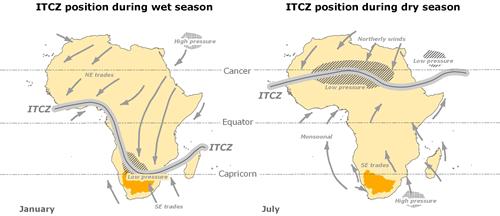Southern Africa can be broadly divided into two Köppen-Geiger climatic groups:
-
Class B - Dry climates: The first group comprises the southwestern countries bordering the Kalahari Desert: Angola, Botswana, Zimbabwe, Namibia and South Africa, with climates ranging from semi-arid and sub-humid in the east, to hyper-arid in the west
-
Class C - Moist mid-latitude climates with mild winters, comprising the eastern countries Tanzania, Malawi, Mozambique, Swaziland, Lesotho and the Indian Ocean island countries, with climatic conditions ranging from Dry to Moist Subtropical Mid-Latitude conditions
Southern Africa is located between the Atlantic Ocean and Indian Ocean, with high pressure zones on the west and east, respectively. The region is prone to frequent droughts and uneven rainfall distribution. The region has two distinct seasons – a wet season roughly from November to April, and a dry season roughly from May to October. The wet season occurs when the Inter-Tropical Convergence Zone (ITCZ) moves south, bringing rainfall, and the dry season occurs when the ITCZ retreats northward.
Oceans play an important role in the region’s climate. The east coast is influenced by the southward-flowing Mozambique current, which brings warm water and humid air from the Equator and creates a humid, warm climate. In contrast the west coast is influenced by the cold Benguela current from the Atlantic Ocean, which produces a drier climate.
In the interior of southern Africa there is a strong rainfall gradient from east to west. In Swaziland and Lesotho, both altitude and exposure to moist air from the Indian Ocean produce the heaviest and most reliable rainfall. Total rainfall gradually decreases westward, and much of the central and western regions are semi-desert with low and variable rainfall. the exception to this is the souther and wetstern Cape regions of South Africa, which are influneced by maritime conditions and recieve winter rainfall as part of a more temperate climate.
Over the whole of this interior region, rainfall mainly occurs in the summer season in the form of thunderstorms. Large daily and seasonal temperature ranges are also observed as a result of altitude and interioe “continental” location (i.e., the lack of ocean influences). Winters are usually dry and sunny, while summers are wet and hot. Frost is a frequent occurrence in the winter, and snow is common above 1 500 meters. This variability in weather patterns, possibly due to lcimate change, sometimes results in droughts and floods, which adversely affect human activities.

Inter-Tropical Convergence Zone (ITCZ) variation across Africa throughout the year.
Source:Ker et al. 1978
( click to enlarge )
Rainfall in southern Africa is strongly influenced by the ITCZ. The ITCZ changes position during the year, moving between the Equator and the Tropics of Cancer and Capricorn. Southern Africa normally receives the bulk of its annual rainfall from November through March as the ITCZ moves south. The further south the zone moves, the more promising the rainy season. The average positions of ITCZ in July and January in the above figure illustrate this situation.
In a normal southern African rainy season, the ITCZ influence covers central Tanzania to southern Zimbabwe and is associated with favourable rainfall. The “Botswana High” pressure system tends to push the ITCZ away, often resulting in periods of drought.
